ReviewsBooks
Oct 6, 2015

The Lives of Colonial Objects
Edited by Annabel Cooper, Lachy Paterson and Angela Wanhalla.
Otago University Press
RRP: $49.95
Review nā Adrienne Rewi
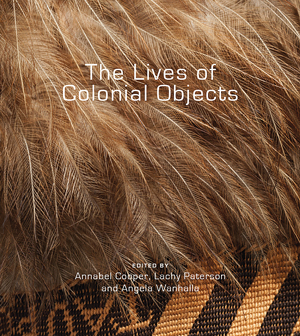 When I read about the tāniko slippers now in the Auckland War Memorial Museum, I think of growing up in a family of makers – knitters, embroiderers, quilters, woodworkers and model-makers – whānau who unwittingly entwined something of their personal lives and circumstances into their craft.
When I read about the tāniko slippers now in the Auckland War Memorial Museum, I think of growing up in a family of makers – knitters, embroiderers, quilters, woodworkers and model-makers – whānau who unwittingly entwined something of their personal lives and circumstances into their craft.
This is what The Lives of Colonial Objects is all about – a collection of beautifully photographed museum objects, and the intimate tales of their making. It’s the way history should be approached – unfolded, revealed, inspected, and deliberated upon through the accessible, everyday objects made by the ordinary people of their time.
There’s a chapter for every object, written by historians, archivists, curators, and Māori scholars. They look into the “lives” of treasured family possessions such as family diaries, a cherished kahu kiwi, a music album, Katherine Mansfield’s hei tiki, a stamp collection, and of course, those fabulous tāniko slippers.
The slippers were owned by the celebrated Muaūpoko leader, Te Keepa Te Rangihiwinui, or Major Kemp as he was commonly known, rangatira of Pūtiki Marae, Whanganui. Major Kemp excelled and was greatly respected in both the Māori and Pākehā worlds, and his tāniko slippers – their making explained in detail by writers Chanel Clarke and Catherine Smith – mark him out as a man of style and good taste.
When he died in 1898, his only daughter, Wikitōria, inherited most of his estate. She gave his tāniko slippers to her father’s great friend, John Roderick McDonald, one of the largest Pākehā landholders in the Horowhenua district. He spoke fluent Māori and was both “a great supporter of the Māori race” and a keen purchaser of Māori land. McDonald’s granddaughters recently gave the slippers to the Auckland War Memorial Museum.
There’s another fascinating tale about the Weller brothers’ medicine chest (Otago Peninsula Museum), written by Jonathan West. The brothers, sons of a wealthy English family, founded a variety of business interests. West relates the tale of Octavius Harwood, a clerk for the brothers’ Ōtākou whaling station, who became the “makeshift physician” to the station Dr Joseph Cochrane, the only doctor in Te Waipounamu, was assaulted.
Four Kāi Tahu villages lay close to the whaling station in the late 1830s, and Harwood had an important role in brokering relationships with those communities. He traded with Kāi Tahu leaders, employed Kāi Tahu as whalers, and in 1839, he married Tītapu, the daughter of Kāi Tahu rangatira, Pokene.
Throughout this book – easily picked up and read in bite-sized individual chapters – there’s an underlying reverence for the everyday objects we so often take for granted, and the “secrets” and stories they have woven into their fabric. It throws a captivating light on lives past.
 Adrienne Rewi, a communications advisor at Te Rūnanga o Ngāi Tahu, is a widely-known writer of books, journalism, travel guides, speeches, blogs, tweets and grocery lists. She is also a keen photographer and avid reader.
Adrienne Rewi, a communications advisor at Te Rūnanga o Ngāi Tahu, is a widely-known writer of books, journalism, travel guides, speeches, blogs, tweets and grocery lists. She is also a keen photographer and avid reader.
Hocken, Prince of Collectors
Donald Jackson Kerr
Otago University Press
RRP: $60
Review nā Mark Revington
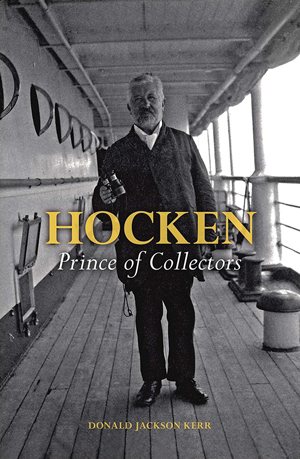 Dr Thomas Morland Hocken arrived in Dunedin in 1862. He was 26 years old. He began collecting almost immediately. Books, manuscripts, maps, sketches… they were all grist to his mill. He would go on to amass such a vast collection of post-contact writing that, after his death, it was gifted to the Otago Museum where it became the Hocken Library, now in new premises and often called the jewel in the research crown of the University of Otago.
Dr Thomas Morland Hocken arrived in Dunedin in 1862. He was 26 years old. He began collecting almost immediately. Books, manuscripts, maps, sketches… they were all grist to his mill. He would go on to amass such a vast collection of post-contact writing that, after his death, it was gifted to the Otago Museum where it became the Hocken Library, now in new premises and often called the jewel in the research crown of the University of Otago.
Hocken’s contemporaries, Alexander Turnbull and Sir George Grey, were also notable collectors. Turnbull has a library named after him in Wellington, while Grey collected books, letters, art, photos, and manuscripts, and also became governor of New Zealand. Perhaps it was something in their DNA. Turnbull began collecting coins at the age of eight and went on to amass a vast collection of books and manuscripts. Hocken just couldn’t help himself, as this densely researched book by historian Donald Kerr makes plain. He developed a passion for New Zealand and Pacific history that included collecting books, manuscripts, sketches, maps, and photos. Not only was Hocken a collector; he was renowned as a public speaker and educator, and known for his lectures on a wide range of topics.
Kerr is Special Collections Librarian and Co-Director of the University of Otago Centre for the Book. He is, it almost goes without saying, passionate about books. In researching this book, he examined Hocken’s whole collection, including his personal papers and correspondence.
He has produced a dense, thorough examination of a man who played a vital part in collecting a record of New Zealand’s early post-contact history.
 Mark Revington is editor of TE KARAKA.
Mark Revington is editor of TE KARAKA.
The Urewera Notebook
By Katherine Mansfield
Edited by Anna Plumridge
Otago University Press
RRP: $49.95
Review nā Martin Fisher
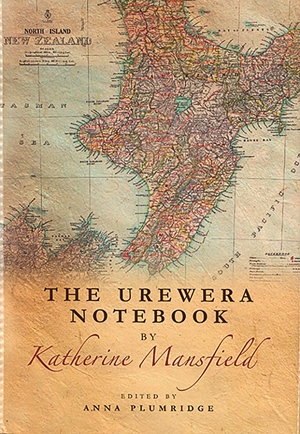 Katherine Mansfield’s The Urewera Notebook, edited by Victoria University of Wellington post-graduate student Anna Plumridge, has been used in a myriad of different ways by scholars over the years. Originally it was used by her husband, John Middleton Murry, to show that Mansfield had disliked her life in colonial New Zealand. Later it was revised under the work of more independent scholars such as Ian A. Gordon and Margaret Scott to portray Mansfield enjoying herself in New Zealand. Plumridge provides the most accurate reproduction of the work, and helpfully highlights the positive and negative effects of previous uses of the Notebook. The original format, with its lack of punctuation, allows the reader to feel like they are on the journey as descriptions stretch on and on. Some of Plumridge’s most illuminating contributions include emphasising Mansfield’s attitudes towards Māori who she encountered during her camping trip from Hastings to Rotorua and back through Te Urewera.
Katherine Mansfield’s The Urewera Notebook, edited by Victoria University of Wellington post-graduate student Anna Plumridge, has been used in a myriad of different ways by scholars over the years. Originally it was used by her husband, John Middleton Murry, to show that Mansfield had disliked her life in colonial New Zealand. Later it was revised under the work of more independent scholars such as Ian A. Gordon and Margaret Scott to portray Mansfield enjoying herself in New Zealand. Plumridge provides the most accurate reproduction of the work, and helpfully highlights the positive and negative effects of previous uses of the Notebook. The original format, with its lack of punctuation, allows the reader to feel like they are on the journey as descriptions stretch on and on. Some of Plumridge’s most illuminating contributions include emphasising Mansfield’s attitudes towards Māori who she encountered during her camping trip from Hastings to Rotorua and back through Te Urewera.
Mansfield’s portrayals could often fall under the colonial predisposition to romanticise the noble savage (and feed into the stereotypes of a dying conquered race), such as her description of “little whares…very old and desolate – almost haunted”. But she also showed a respect for Māori that would have been quite rare at the time, and especially among her camping party. At Te Whaiti she noted the prevalent poverty, but also highlighted the refinement of a struggling mother with many children who had a “splendid face and regal bearing”. She described the party’s European and Ngāti Rangitihi guide Albert Warbrick in similar terms, and marvelled at how he and his family adopted both Māori and European lifestyles. Ultimately though, Mansfield’s Notebook reveals less about Māori, and more about what made white people tick. In Mansfield’s case it reflected her privileged upbringing, but also some attributes missing from many of her colonial contemporaries – just enough curiosity and some empathy.
 Martin Fisher was born in Budapest, Hungary but was raised in Canada and New Zealand. He is a lecturer at the Ngāi Tahu Research Centre at the University of Canterbury.
Martin Fisher was born in Budapest, Hungary but was raised in Canada and New Zealand. He is a lecturer at the Ngāi Tahu Research Centre at the University of Canterbury.
Arohanui: Revenge of the Fey
Nā Helen Pearse-Otene
Huia Publishers
RRP: $25.00
Review nā Te Rakitaunuku Tau
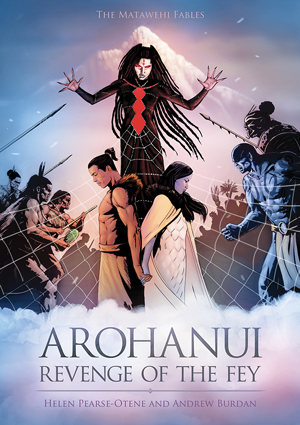 Arohanui — Revenge of the Fey is a tale of two rival factions. The Kaitipua, the warlike ancestors of man, have forgotten the old ways, and are now in a time of famine and desolation. They are led by a strong chief, Parekoi, who is desperate for a solution to their plight. The other faction is the Parehe, the fantastically drawn guardians of nature who remember the old ways of nature and the land, and possess the solution to the Kaitipua’s adversity. I will end my plot summary here so as not to divulge any further spoilers for interested readers.
Arohanui — Revenge of the Fey is a tale of two rival factions. The Kaitipua, the warlike ancestors of man, have forgotten the old ways, and are now in a time of famine and desolation. They are led by a strong chief, Parekoi, who is desperate for a solution to their plight. The other faction is the Parehe, the fantastically drawn guardians of nature who remember the old ways of nature and the land, and possess the solution to the Kaitipua’s adversity. I will end my plot summary here so as not to divulge any further spoilers for interested readers.
I really enjoyed this graphic novel for many reasons, but I’ll start with the illustration. As a bit of a geek, I’ve read a lot of comics, and this one is certainly up there. The Parehe are a standout here as a well-drawn fusion of contemporary supernatural comic book characters and Māori warriors. As soon as the reader sees them he/she is immediately interested in the tale. I also enjoyed the book’s depiction of what a pre-European Māori settlement may have looked like. I’d give the illustration a strong 9/10. Moving on to the plot, I really liked the slightly Romeo and Juliet theme tied in with the mythical legend vibe of the story. The characters developed nicely, and some had a surprising amount of depth, considering the length of the story. Often I was debating who I was rooting for! I really enjoyed this book and would recommend it to all.
Meariki: The Quest for Truth
Nā Helen Pearse-Otene
Huia Publishers
RRP: $25.00
Review nā Te Rakitaunuku Tau
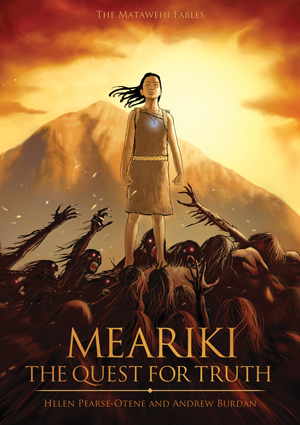 Meariki: The Quest for Truth is the tale of a young woman, Hineamuru, who is high in her village’s hierarchy. Hineamuru is kidnapped by a dangerous warlock and taken to his lair by his spectacularly-drawn eagle. A lowly slave, who happens to be a descendant of the mysterious Parehe (see previous review), along with Hineamuru’s beloved, Pēhi, go on a rescue mission to save Hineamuru from the clutches of the dastardly warlock.
Meariki: The Quest for Truth is the tale of a young woman, Hineamuru, who is high in her village’s hierarchy. Hineamuru is kidnapped by a dangerous warlock and taken to his lair by his spectacularly-drawn eagle. A lowly slave, who happens to be a descendant of the mysterious Parehe (see previous review), along with Hineamuru’s beloved, Pēhi, go on a rescue mission to save Hineamuru from the clutches of the dastardly warlock.
I enjoyed this book, and again the illustrations were a stand out for me. Illustrator Andrew Burdan continues to draw captivating images such as the giant eagle, evil warlock (again combining contemporary superhero/villain design with Māori influences), two-headed dog, and all the other supernatural creatures of the story. Each and every one of these were a credit to the author’s creativity, as they all seemed to spring to life in my imagination. I could easily see in my mind the eagle soaring across the skies or the great dream weaver Te Moepapa bounding along with his two headed dog. Good illustration is important to any comic book and this one nailed it.
Moving along to the plot, I found two things particularly stood out in this book compared with Arohanui. Arohanui was fantastic, but something Meariki has up on it is the small bits of humour, like when Pēhi becomes a pig and all his snotty remarks. These are appropriate and in no way ruin the story, but add enjoyment for the reader.
The second thing is the very supernatural plotline. I enjoyed all the mysterious weapons and creatures that constantly appeared throughout the storyline, as they added an element of wonder and intrigue. One example is the fire dagger crafted by the children of fire goddess Mahuika. Such things left me intrigued and wanting to know how they could be used and what would happen.
 Te Rakitaunuku Tau (Ngāi Tahu, Te Ngāi Tūāhuriri): “One hell of a guy.” NY Times; “Absolute lad.” Jesus Christ; “Swipe right.” Tinder; “A trusted friend and ally.” Barack Obama
Te Rakitaunuku Tau (Ngāi Tahu, Te Ngāi Tūāhuriri): “One hell of a guy.” NY Times; “Absolute lad.” Jesus Christ; “Swipe right.” Tinder; “A trusted friend and ally.” Barack Obama
Opinions expressed in REVIEWS are those of the writers and are not necessarily endorsed by Te Rūnanga o Ngāi Tahu.